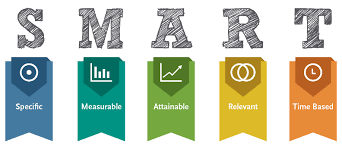
Goals serve as a guide to what an organization wants to achieve. Goal setting is a vital activity because it determines the broad vision and direction of an organization’s business plan. The best project goals will align with the organization’s mission, vision, and culture, describe business aspirations, and pave the way for more specific project objectives. While it’s easy to create generalized goals, productivity is stunted because there are no specifics being defined.
Table of contents
- Goals vs objectives
- SMART goals
- SMART objectives
- Examples of SMART objectives
- SMART goal template
- Ready to start writing your SMART goals?
Goals vs objectives
Although some professionals use the terms interchangeably, goals and objectives have differences and important implications. Goals define the general intentions and ambitions of a company, making them difficult to measure. Goal setting helps companies and teams motivate themselves toward a destination or achievement. A generic project goal can be motivating, but adding precise objectives allows the company to reach goals effectively. An effective way of goal setting is to create SMART goals.

Read also: Struggling to Align Your Innovation Goals With Your Business Needs?
SMART Goals
George T. Doran developed the SMART goal planning acronym in 1981 to make goal setting more practical. It helps organizations set their goals and objectives in a more practical way. The SMART method readies individuals and teams for increased productivity. They can focus their efforts, clarify their ideas, use their time and resources wisely, and increase their chances of achieving more. The SMART goals acronym stands for:
S-pecific M-easurable A-chievable R-elevant T-ime bound
SMART Objectives
Once a project goal is set, setting objectives is the next step to advancing with a clear understanding of how to reach the desired outcome. The difference of objectives from goals is that objectives are precise actions or measurable steps that companies and teams can take to move closer to their goals.
Specific
Specific answers the question, ‚Äòwhat needs to be done?’ and ‚Äòhow do we know it is done?’ It should also describe the end result of the specific work. By specific, the project manager formats the objective statement in the way that everyone who reads it interprets it the same way. It helps to use the 5W method, namely:
- What do I want to accomplish?
- Who is involved in this?
- Which resources are involved?
- Where is it located?
- Why is it important?
Measurable
Measurable answers the question, ‚Äòhow do I know it meets expectations?’ It also answers ‚Äòhow much’ or ‚Äòhow many’ the stakeholders expect to achieve. When checking for this, quantifiable terms like costs, deadlines, frequency, quality, and quantity are helpful. Additionally, groups should make sure that they can measure objectives against any specific standard. There are two types of measurements: quantity measurement and frequency measurement. Quantity measurements would be percentages, while frequency measurements can be daily, weekly, or bi-weekly, among others. The issue with measurable objectives is that they are difficult to formulate. As a result, stakeholders trade objectives that add more value to the business for those that are measurable.
Achievable
Achievable answers the question ‚Äòcan I achieve it?’ or ‚Äòis this goal achievable by this person?’ or ‚Äòam I equipped with the necessary skills and knowledge to meet the expectation?’ Furthermore, teams and companies should take note of the constraints that can hinder them from achieving their goals. An objective shouldn’t be too high to be stressful for anyone to even try to achieve it. It shouldn’t be too simple or low that it wouldn’t push a team or individual to realize their potential. It should be ideal but within reach to ensure that it is possible without causing undue stress.
Relevant
Relevant answers the question ‘do the goals align with the business strategies?’ They have to be relevant and tie up to the company’s mission and vision. This is best achieved by employees consulting with their managers on how they can formulate relevant objectives. In order for a company to succeed, its employees should also aim for goals that are in line with the organization’s goals. Otherwise, organizations and employees will not harmoniously journey towards development. Organization leaders sometimes interpret R in SMART as Realistic, Reasonable, Resonant, or Results-based. While the exact definition of R is not critical, it should be meaningful and not redundant to the other acronyms. For example, Achievable and Realistic are somewhat close in meaning, so Realistic does not particularly add significantly to the method. However, Relevant adds the criteria that objectives should align with strategic direction. Goals can be attainable and realistic but do not necessarily move the company in the desired direction.
Time-bound
Time-bound answers the question ‘when will it be done?’ Objectives have to have a deadline. Life moves fast and if people don’t have a timeline to follow, tomorrow may be too late. Nobody likes deadlines, but they are important. Without setting a timeline, people will keep procrastinating and achieve nothing. In some instances, tasks have a fixed end-point or a milestone. Other times, a task’s end signifies the start of another.
Examples of SMART Objectives
Here are some examples of what SMART objectives look like compared to ones that are not.
Not SMART: Increase sales by 100 percent.
SMART: To achieve $5,000 worth of annual orders of books spread throughout the four quarters of the year, with the first quarter hitting $1,000, the second quarter hitting $1,000, the third quarter hitting $1,500, and the fourth quarter hitting $1,500.
In this example, the writer stated everything clearly. The goal is specific: achieve annual orders worth $5,000. It is also measurable because the writer identified the cost of these annual orders. The goal is time-bound because it specifies that the cost of orders is for a year, spread throughout the four quarters.
Not SMART: Improve the communication skills of employees by holding seminars.
SMART: Improve the written and spoken communication skills of 60 percent of employees by holding one seminar for every quarter of 2020.
This objective is SMART because it is specific, measurable (60 percent of employees), achievable, relevant, and time-bound (every quarter of 2020).
Not SMART: Pay off all debts by the end of this year.
SMART: Pay off $10,000 worth of debts in 48 months.
This example is very practical. The writer specifies the amount to pay identified as debt. A timeline is also set: 48 months.
Variations to the SMART objectives
As many organizations see the effectiveness of using SMART objectives, they have made several variations to it. For example, there is SMART-C where C stands for challenging. Another one is SMART-S where S stands for sustainable. With these, the goals continue beyond the timeline provided.
SMART goals template
Creating a SMART goals template that you can use to evaluate your project goals is easy. Use this guide to make sure your goals follow the SMART acronym to create specific, measurable, achievable, relevant, and time-bound project objectives.
Specific
Target a specific area of improvement. Under this section, specify in descending order your
I) Goals
II) Objectives
III) Projects
IV) Milestones
V) Activities
Make sure all these entries are actionable in a specific and meaningful way.
Measurable
This section allows you to quantify or at least suggest an indicator of progress. Describing your goals in a measurable way creates an objective that you can track your progress on. It can be a numeric or percentage target.
Achievable
Achievable goals are objectives assigned to accountable teams and members. This section specifies who are responsible for the goals’ achievement.
Relevant
It is important to clearly describe the goal you want to achieve to make sure it is relevant to the company and/or team. It provides context and justification on why the stakeholders created the project or task, what their intentions are for the deliverables, and why they are relevant to the company.
Time-bound
Specify in this section when your team is likely to achieve the results. Outline the appropriate timelines for execution. Be thoughtful on the time period that will transpire during the project execution. An appropriate timeline will assist team members in working on priorities.
Ready to start writing your SMART goals?
The SMART goal setting method has proven its usefulness to individuals and organizations. But more than creating these objectives, employees or team members should have the drive and motivation to achieve these objectives. An organization’s success largely depends on the concerted efforts of the organization and its members. Moreover, after establishing project goals and mapping out SMART objectives, project managers have to measure project progress to make sure it is on track towards targets. Teams use a variety of goal-tracking methods, tools, and project management software to help measure progress towards outcomes and promote accountability.
To learn more about Project Management, check out TechRepublic Academy.
Featured Partners: Project Management Software














